Paper Menu >>
Journal Menu >>
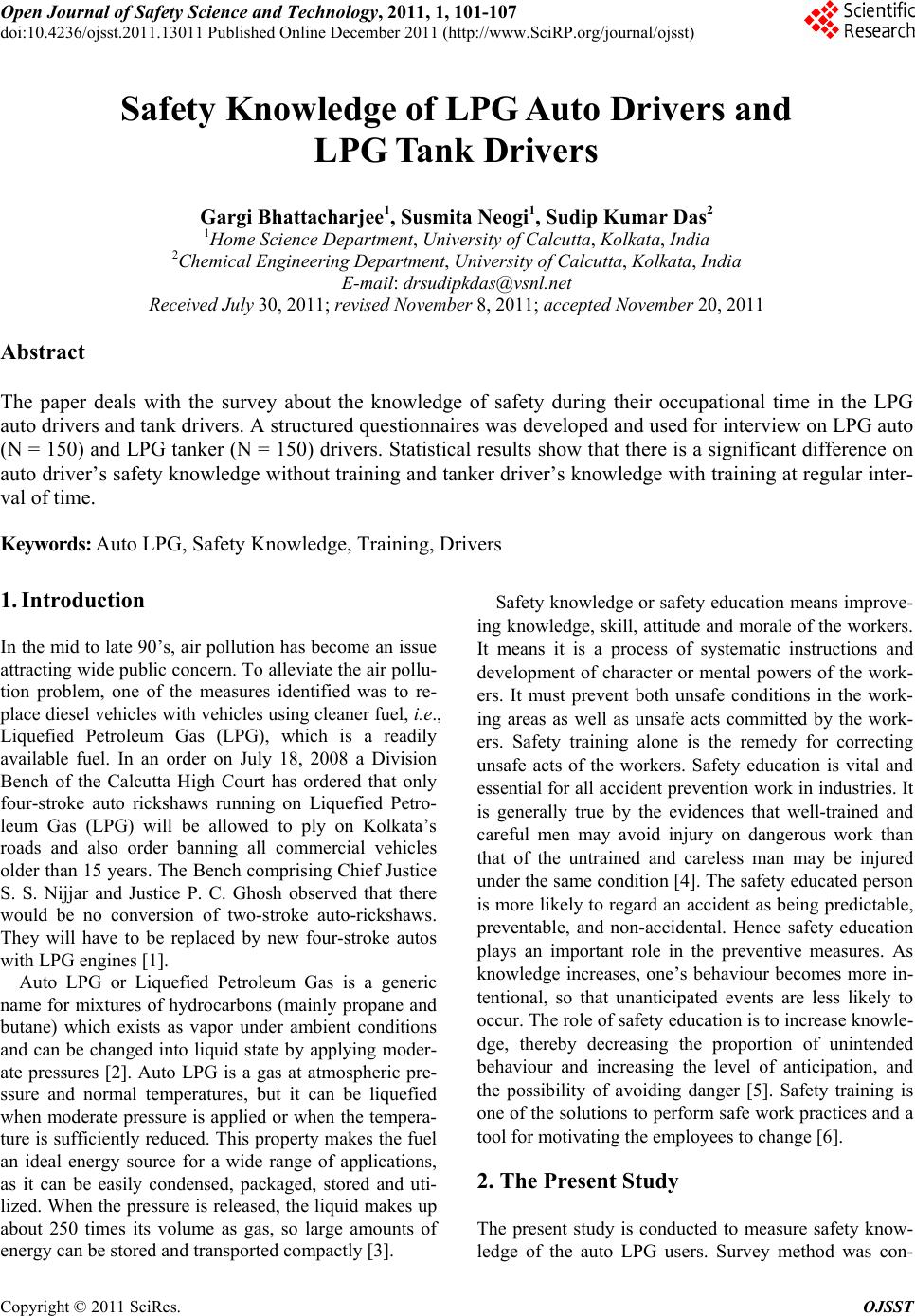 Open Journal of Safety Science and Technology, 2011, 1, 10 1-107 doi:10.4236/ojsst.2011.13011 Published Online December 2011 (http://www.SciRP.org/journal/ojsst) Copyright © 2011 SciRes. OJSST Safety Knowledge of LPG Auto Drivers and LPG Tank Drivers Gargi Bhattacharjee1, Susmita Neogi1, Sudip Kumar Das2 1Home Science De partment, University of Calcutta, Kolkata, India 2Chemical Engineering Dep artment, University of Calcutta, Kolkata, India E-mail: drsudipkdas@vsnl.net Received July 30, 201 1; revised November 8, 2011; accepted November 20, 2011 Abstract The paper deals with the survey about the knowledge of safety during their occupational time in the LPG auto drivers and tank drivers. A structured questionnaires was developed and used for interview on LPG auto (N = 150) and LPG tanker (N = 150) drivers. Statistical results show that there is a significant difference on auto driver’s safety knowledge without training and tanker driver’s knowledge with training at regular inter- val of time. Keywords: Auto LPG, Safety Knowledge, Training, Drivers 1. Introduction In the mid to late 90’s, air pollution has beco me an issue attracting wide public concern. To alleviate the air pollu- tion problem, one of the measures identified was to re- place diesel vehicles with vehicles using cleaner fuel, i.e., Liquefied Petroleum Gas (LPG), which is a readily available fuel. In an order on July 18, 2008 a Division Bench of the Calcutta High Court has ordered that only four-stroke auto rickshaws running on Liquefied Petro- leum Gas (LPG) will be allowed to ply on Kolkata’s roads and also order banning all commercial vehicles older than 15 years. The Bench comprising Chief Justice S. S. Nijjar and Justice P. C. Ghosh observed that there would be no conversion of two-stroke auto-rickshaws. They will have to be replaced by new four-stroke autos with LPG engines [1]. Auto LPG or Liquefied Petroleum Gas is a generic name for mixtures of hydrocarbons (mainly propane and butane) which exists as vapor under ambient conditions and can be changed into liquid state by applying moder- ate pressures [2]. Auto LPG is a gas at atmospheric pre- ssure and normal temperatures, but it can be liquefied when moderate pressure is applied or when the tempera- ture is sufficiently reduced. This prop erty makes the fuel an ideal energy source for a wide range of applications, as it can be easily condensed, packaged, stored and uti- lized. When the pressure is released, the liquid makes up about 250 times its volume as gas, so large amounts of energy can be st or ed and transported compactly [3]. Safety knowledge or safety education means improve- ing knowledge, skill, attitud e and morale of the workers. It means it is a process of systematic instructions and development of character or mental powers of the work- ers. It must prevent both unsafe conditions in the work- ing areas as well as unsafe acts committed by the work- ers. Safety training alone is the remedy for correcting unsafe acts of the workers. Safety education is vital and essential for all accident prevention work in industries. It is generally true by the evidences that well-trained and careful men may avoid injury on dangerous work than that of the untrained and careless man may be injured under the same condition [4]. The safety educated person is more likely to regard an accident as being predictable, preventable, and non-accidental. Hence safety education plays an important role in the preventive measures. As knowledge increases, one’s behaviour becomes more in- tentional, so that unanticipated events are less likely to occur. The role of safety education is to increase knowle- dge, thereby decreasing the proportion of unintended behaviour and increasing the level of anticipation, and the possibility of avoiding danger [5]. Safety training is one of the solutions to perform safe work practices and a tool for motivating the employees to change [6]. 2. The Present Study The present study is conducted to measure safety know- ledge of the auto LPG users. Survey method was con- 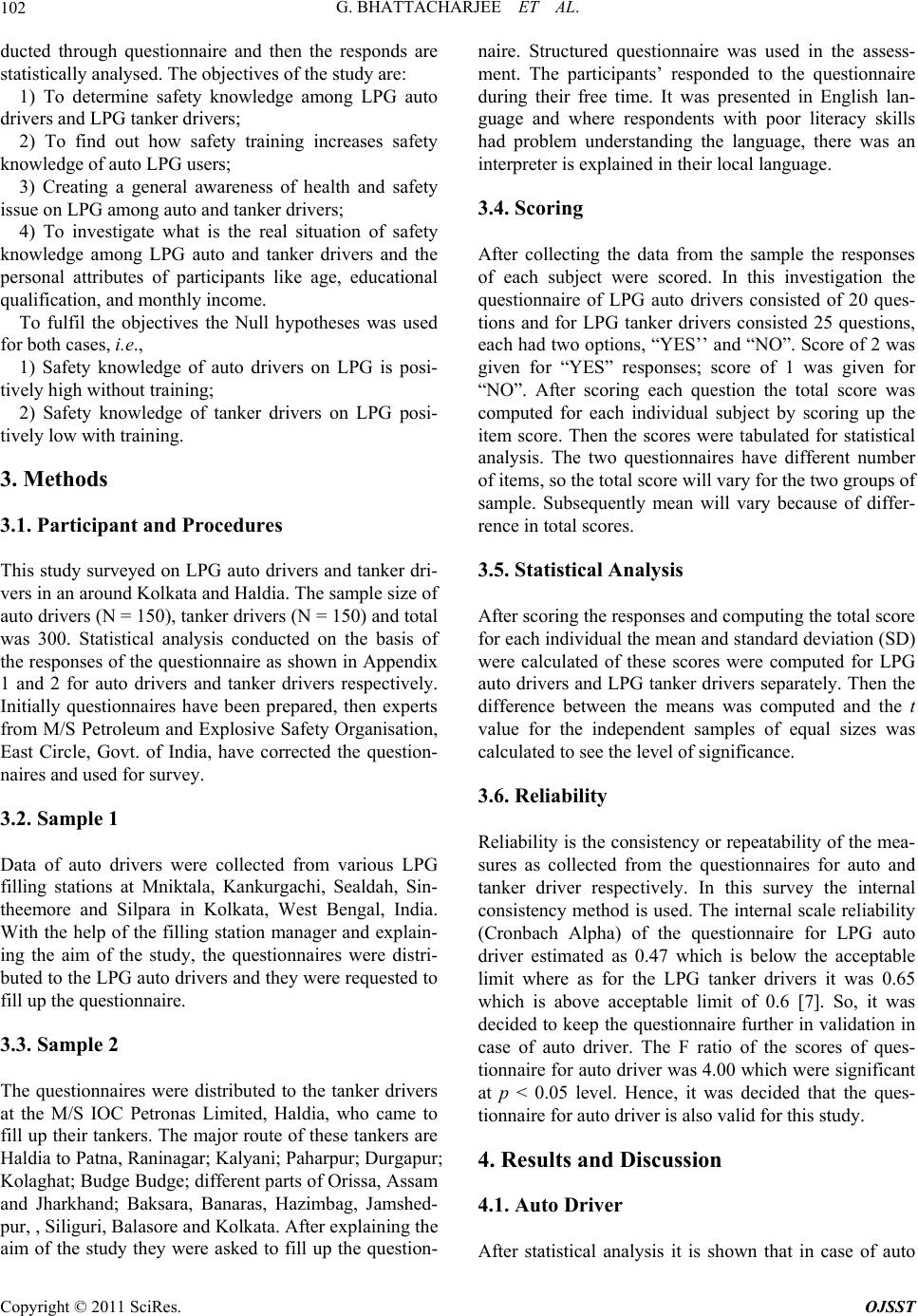 G. BHATTACHARJEE ET AL. 102 ducted through questionnaire and then the responds are statistically analysed. The objectives of the study are: 1) To determine safety knowledge among LPG auto drivers and LPG tanker drivers; 2) To find out how safety training increases safety knowledge of auto LPG users; 3) Creating a general awareness of health and safety issue on LPG among auto and tanker drivers; 4) To investigate what is the real situation of safety knowledge among LPG auto and tanker drivers and the personal attributes of participants like age, educational qualification, and monthly income. To fulfil the objectives the Null hypotheses was used for both cases, i.e., 1) Safety knowledge of auto drivers on LPG is posi- tively high without training; 2) Safety knowledge of tanker drivers on LPG posi- tively low with training. 3. Methods 3.1. Participant and Procedures This study surveyed on LPG auto drivers and tanker dri- vers in an around Kolkata and Haldia. The sample size of auto drivers (N = 150) , tanker dr ivers (N = 150) and to tal was 300. Statistical analysis conducted on the basis of the responses of the questio nnaire as shown in Appendix 1 and 2 for auto drivers and tanker drivers respectively. Initially questionnaires have been prepared, then experts from M/S Petroleum and Explosive Safety Organisation, East Circle, Govt. of India, have corrected the question- naires and used for survey . 3.2. Sample 1 Data of auto drivers were collected from various LPG filling stations at Mniktala, Kankurgachi, Sealdah, Sin- theemore and Silpara in Kolkata, West Bengal, India. With the help of the filling station manager and explain- ing the aim of the study, the questionnaires were distri- buted to the LPG au to drivers and they were requested to fill up the questionnaire. 3.3. Sample 2 The questionnaires were distributed to the tanker drivers at the M/S IOC Petronas Limited, Haldia, who came to fill up their tankers. The major route of these tankers are Haldia to Patna, Raninagar; Kalyani; Paharpur; Durgapur; Kolaghat; Budge Budge; different parts of Orissa, Assam and Jharkhand; Baksara, Banaras, Hazimbag, Jamshed- pur, , Siliguri, Balasore and Kolkata. After explaining the aim of the study they were asked to fill up the question- naire. Structured questionnaire was used in the assess- ment. The participants’ responded to the questionnaire during their free time. It was presented in English lan- guage and where respondents with poor literacy skills had problem understanding the language, there was an interpreter is explained in their local language. 3.4. Scoring After collecting the data from the sample the responses of each subject were scored. In this investigation the questionnaire of LPG auto drivers consisted of 20 ques- tions and for LPG tanker drivers consisted 25 questions, each had two options, “YES’’ and “NO”. Score of 2 was given for “YES” responses; score of 1 was given for “NO”. After scoring each question the total score was computed for each individual subject by scoring up the item score. Then the scores were tabulated for statistical analysis. The two questionnaires have different number of items, so the total score will vary for the two groups of sample. Subsequently mean will vary because of differ- rence in total scores. 3.5. Statistical Analysis After scoring the responses an d co mputin g the total score for each individual the mean and standard deviation (SD) were calculated of these scores were computed for LPG auto drivers and LPG tanker drivers separately. Then the difference between the means was computed and the t value for the independent samples of equal sizes was calculated to see the level of significance. 3.6. Reliability Reliability is the consisten cy or repeatability of the mea- sures as collected from the questionnaires for auto and tanker driver respectively. In this survey the internal consistency method is used. The internal scale reliability (Cronbach Alpha) of the questionnaire for LPG auto driver estimated as 0.47 which is below the acceptable limit where as for the LPG tanker drivers it was 0.65 which is above acceptable limit of 0.6 [7]. So, it was decided to keep the questionnaire further in validation in case of auto driver. The F ratio of the scores of ques- tionnaire for auto driver was 4.00 which were significant at p < 0.05 level. Hence, it was decided that the ques- tionnaire for auto driver is also valid for this study. 4. Results and Discussion 4.1. Auto Driver After statistical analysis it is shown that in case of auto Copyright © 2011 SciRes. OJSST 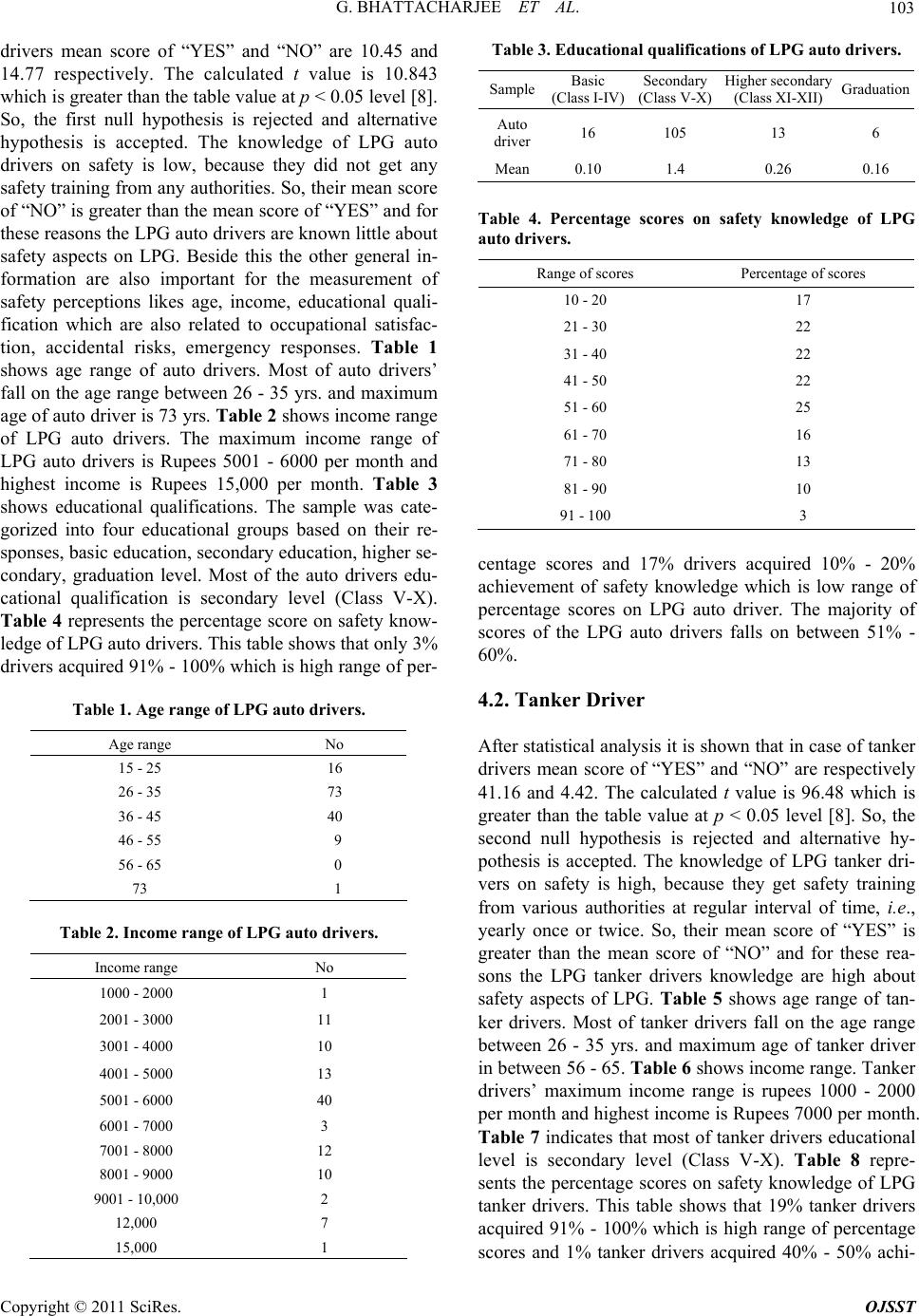 G. BHATTACHARJEE ET AL.103 drivers mean score of “YES” and “NO” are 10.45 and 14.77 respectively. The calculated t value is 10.843 which is greater than the tab le value at p < 0.05 level [8]. So, the first null hypothesis is rejected and alternative hypothesis is accepted. The knowledge of LPG auto drivers on safety is low, because they did not get any safety training from any authorities. So, their mean score of “NO” is gr eater than th e mean scor e of “YES” an d for these reasons the LPG auto drivers are known little about safety aspects on LPG. Beside this the other general in- formation are also important for the measurement of safety perceptions likes age, income, educational quali- fication which are also related to occupational satisfac- tion, accidental risks, emergency responses. Table 1 shows age range of auto drivers. Most of auto drivers’ fall on the age range between 26 - 35 yrs. and maximum age of auto driver is 73 yrs. Table 2 shows income range of LPG auto drivers. The maximum income range of LPG auto drivers is Rupees 5001 - 6000 per month and highest income is Rupees 15,000 per month. Table 3 shows educational qualifications. The sample was cate- gorized into four educational groups based on their re- sponses, basic education, secondary education, higher se- condary, graduation level. Most of the auto drivers edu- cational qualification is secondary level (Class V-X). Table 4 represents the percentage score on safety know- ledge of LPG auto drivers. This table shows that on ly 3% drivers acquired 91% - 100% which is high range of per- Table 1. Age range of LPG auto drivers. Age range No 15 - 25 16 26 - 35 73 36 - 45 40 46 - 55 9 56 - 65 0 73 1 Table 2. Income range of LPG auto drivers. Income range No 1000 - 20001 2001 - 3000 11 3001 - 4000 10 4001 - 5000 13 5001 - 6000 40 6001 - 7000 3 7001 - 8000 12 8001 - 9000 10 9001 - 10,000 2 12,000 7 15,000 1 Table 3. Educational qualifications of LPG auto drivers. Sample Basic (Class I-IV)Secondary (Class V-X) Higher secondar y (Class XI-XII) Graduation Auto driver 16 105 13 6 Mean 0.10 1.4 0.26 0.16 Table 4. Percentage scores on safety knowledge of LPG auto drivers. Range of scoresPercentage of score s 10 - 2017 21 - 30 22 31 - 40 22 41 - 50 22 51 - 60 25 61 - 70 16 71 - 80 13 81 - 90 10 91 - 100 3 centage scores and 17% drivers acquired 10% - 20% achievement of safety knowledge which is low range of percentage scores on LPG auto driver. The majority of scores of the LPG auto drivers falls on between 51% - 60%. 4.2. Tanker Driver After statistical analysis it is shown that in case of tanker drivers mean score of “YES” and “NO” are respectively 41.16 and 4.42. The calculated t value is 96.48 which is greater than the table value at p < 0.05 level [8]. So, the second null hypothesis is rejected and alternative hy- pothesis is accepted. The knowledge of LPG tanker dri- vers on safety is high, because they get safety training from various authorities at regular interval of time, i.e., yearly once or twice. So, their mean score of “YES” is greater than the mean score of “NO” and for these rea- sons the LPG tanker drivers knowledge are high about safety aspects of LPG. Table 5 shows age range of tan- ker drivers. Most of tanker drivers fall on the age range between 26 - 35 yrs. and maximum age of tanker driver in between 56 - 65. Table 6 show s inco me rang e. Tanker drivers’ maximum income range is rupees 1000 - 2000 per month and highest income is Rupees 7000 per month. Table 7 indicates that most of tanker drivers educational level is secondary level (Class V-X). Table 8 repre- sents the percentage scores on safety knowledge of LPG tanker drivers. This table shows that 19% tanker drivers acquired 91% - 100% which is high range of percentage scores and 1% tanker drivers acquired 40% - 50% achi- Copyright © 2011 SciRes. OJSST 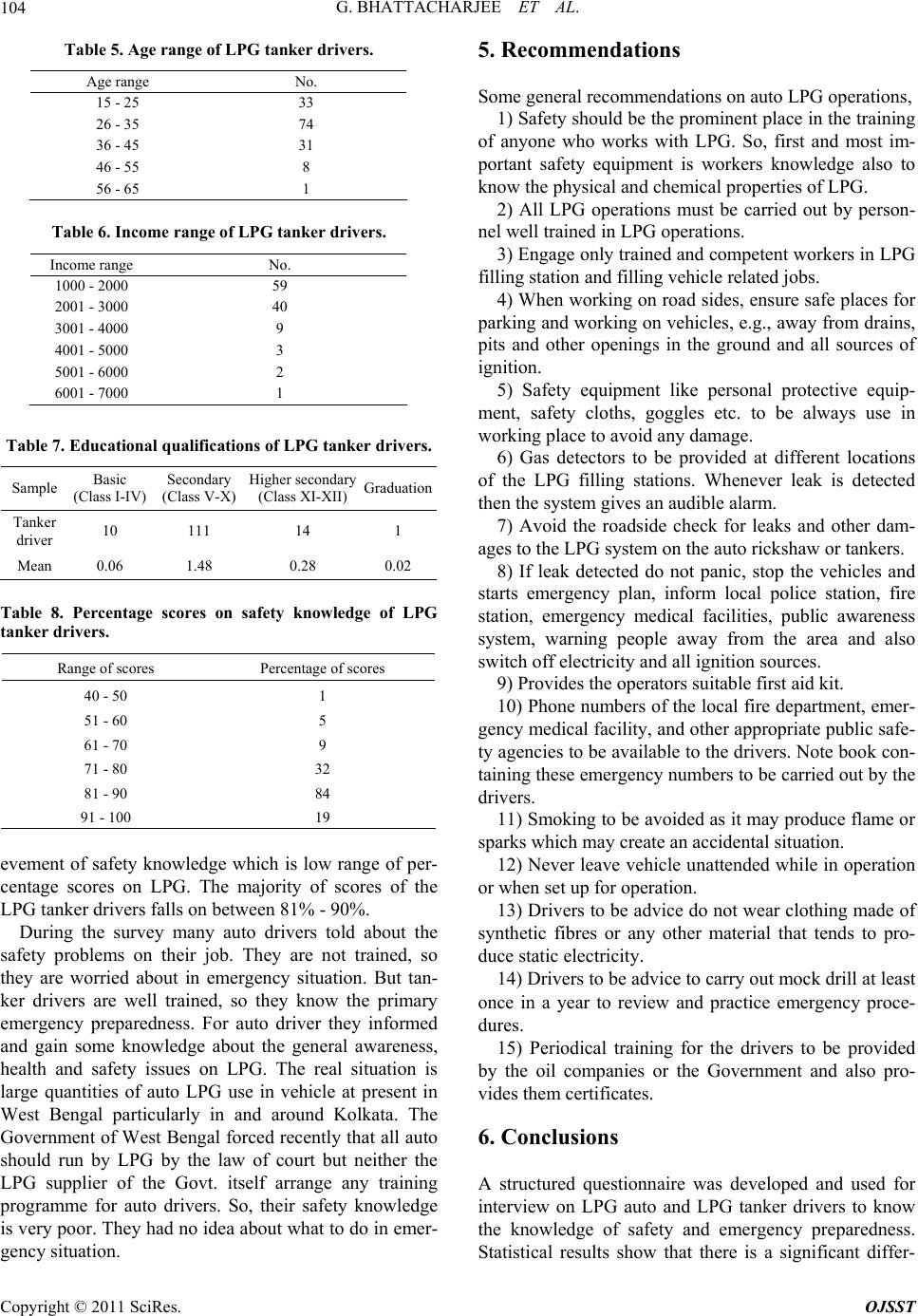 G. BHATTACHARJEE ET AL. 104 Table 5. Age range of LPG tanker drivers. Age range No. 15 - 25 33 26 - 35 74 36 - 45 31 46 - 55 8 56 - 65 1 Table 6. Income range of LPG tanker drivers. Income range No. 1000 - 200059 2001 - 3000 40 3001 - 4000 9 4001 - 5000 3 5001 - 6000 2 6001 - 7000 1 Table 7. Educational qualifications of LPG tanker drivers. Sample Basic (Class I-IV) Secondary (Class V-X)Higher secondary (Class XI-XII) Graduation Tanker driver 10 111 14 1 Mean 0.06 1.48 0.28 0.02 Table 8. Percentage scores on safety knowledge of LPG tanker drivers. Range of scores Percentage of score s 40 - 50 1 51 - 60 5 61 - 70 9 71 - 80 32 81 - 90 84 91 - 100 19 evement of safety knowledge which is low range of per- centage scores on LPG. The majority of scores of the LPG tanker drivers falls on between 81% - 9 0% . During the survey many auto drivers told about the safety problems on their job. They are not trained, so they are worried about in emergency situation. But tan- ker drivers are well trained, so they know the primary emergency preparedness. For auto driver they informed and gain some knowledge about the general awareness, health and safety issues on LPG. The real situation is large quantities of auto LPG use in vehicle at present in West Bengal particularly in and around Kolkata. The Government of West Bengal forced recently that all auto should run by LPG by the law of court but neither the LPG supplier of the Govt. itself arrange any training programme for auto drivers. So, their safety knowledge is very poor. They had no idea about what to do in emer- gency situation. 5. Recommendations Some general recommendations on auto LPG operations, 1) Safety should be the prominent place in the training of anyone who works with LPG. So, first and most im- portant safety equipment is workers knowledge also to know the physical and chemical properties of LPG. 2) All LPG operations must be carried out by person- nel well trained in LPG operations. 3) Engage only trained and competent workers in LPG filling station and fillin g vehicle related jobs. 4) When working on road sides, ensure safe places for parking and working on vehicles, e.g., away from drains, pits and other openings in the ground and all sources of ignition. 5) Safety equipment like personal protective equip- ment, safety cloths, goggles etc. to be always use in working p l a ce to avo i d any damage. 6) Gas detectors to be provided at different locations of the LPG filling stations. Whenever leak is detected then the system gives an audible alarm. 7) Avoid the roadside check for leaks and other dam- ages to the LPG system on the auto rickshaw or tankers. 8) If leak detected do not panic, stop the vehicles and starts emergency plan, inform local police station, fire station, emergency medical facilities, public awareness system, warning people away from the area and also switch off electricity and all ignition sources. 9) Provides the operator s suitable first aid kit. 10) Phone numbers of the local fire department, emer- gency medical facility, and other appropriate public safe- ty agencies to be available to the drivers. Note boo k con- taining these emergency numbers to be carried out by the drivers. 11) Smoking to be avoided as it may produce flame or sparks which may create an accidental situation. 12) Never leave vehicle unattended while in operation or when set up for operation. 13) Drivers to be advice do not wear clothing made of synthetic fibres or any other material that tends to pro- duce static electricity. 14) Drivers to be advice to carry out mock drill at least once in a year to review and practice emergency proce- dures. 15) Periodical training for the drivers to be provided by the oil companies or the Government and also pro- vides them certificates. 6. Conclusions A structured questionnaire was developed and used for interview on LPG auto and LPG tanker drivers to know the knowledge of safety and emergency preparedness. Statistical results show that there is a significant differ- Copyright © 2011 SciRes. OJSST 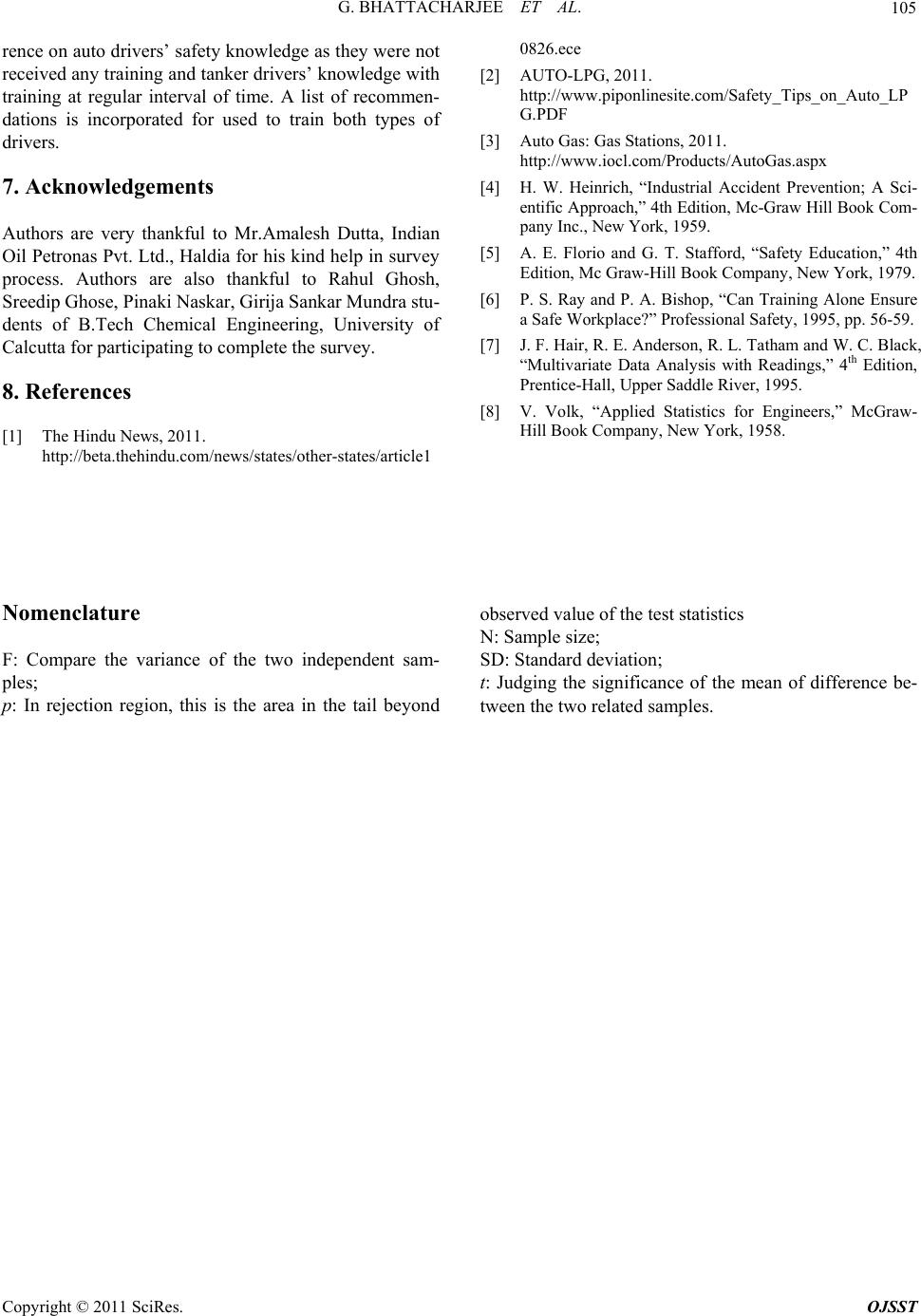 G. BHATTACHARJEE ET AL. Copyright © 2011 SciRes. OJSST 105 rence on auto drivers’ safety knowledge as they were not received any training and tanker drivers’ knowledge with training at regular interval of time. A list of recommen- dations is incorporated for used to train both types of drivers. 7. Acknowledgements Authors are very thankful to Mr.Amalesh Dutta, Indian Oil Petronas Pvt. Ltd., Haldia for his kind help in su rvey process. Authors are also thankful to Rahul Ghosh, Sreedip Ghose , Pin aki Na skar, Girija San kar Mundra stu- dents of B.Tech Chemical Engineering, University of Calcutta for participating to complete the survey. 8. References [1] The Hindu News, 2011. http://beta.thehindu.com/news/states/other-states/article1 0826.ece [2] AUTO-LPG, 2011. http://www.piponlinesite.com/Safety_Tips_on_Auto_LP G.PDF [3] Auto Gas: Gas Stations, 2011. http://www.iocl.com/Products/AutoGas.aspx [4] H. W. Heinrich, “Industrial Accident Prevention; A Sci- entific Approach,” 4th Edition, Mc-Graw Hill Book Com- pany Inc., New York, 1959. [5] A. E. Florio and G. T. Stafford, “Safety Education,” 4th Edition, Mc Graw-Hill Book Company, New York, 1979. [6] P. S. Ray and P. A. Bishop, “Can Training Alone Ensure a Safe Workplace?” Professional Safety, 1995, pp. 56-59. [7] J. F. Hair, R. E. Anderson, R. L. Tatham and W. C. Black, “Multivariate Data Analysis with Readings,” 4th Edition, Prentice-Hall, Upper Saddle River, 1995. [8] V. Volk, “Applied Statistics for Engineers,” McGraw- Hill Book Company, New York, 1958. Nomenclature F: Compare the variance of the two independent sam- ples; p: In rejection region, this is the area in the tail beyond observed value of the test statistics N: Sample size; SD: Standard deviation; t: Judging the significance of the mean of difference be- tween the two related samples. 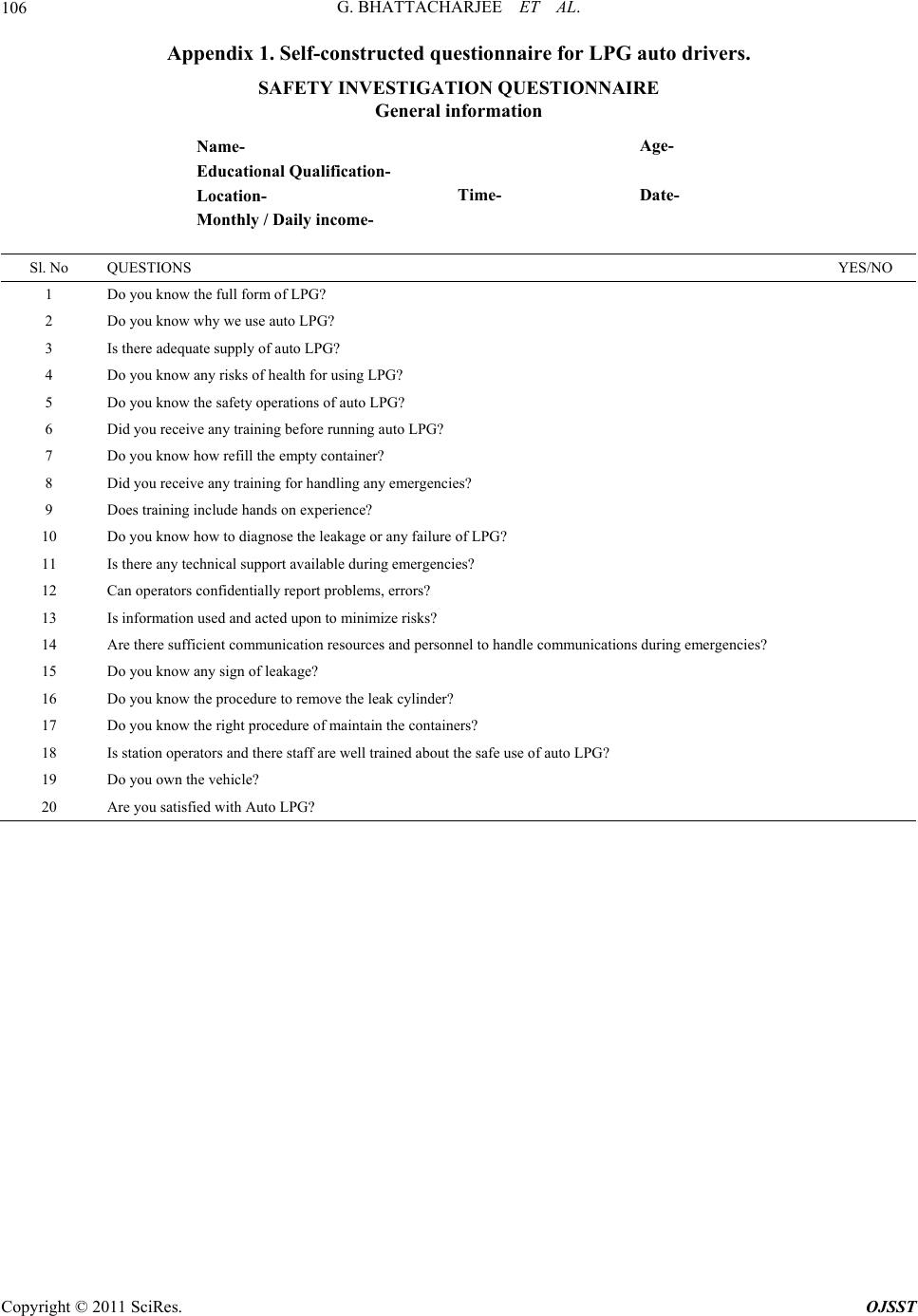 G. BHATTACHARJEE ET AL. Copyright © 2011 SciRes. OJSST 106 Appendix 1. Self-constructed questionnaire for LPG auto drivers. SAFETY INVESTIGATION QUESTIONNAIRE General information Name- Age- Educational Qualification- Location- Time- Date- Monthly / Daily income- Sl. No QUESTIONS YES/NO 1 Do you know the full form of LPG? 2 Do you know why we use auto LPG? 3 Is there adequate supply of auto LP G? 4 Do you know any risks of health for using LPG? 5 Do you know the safety operations of a uto LPG? 6 Did you receive any training before running auto LPG? 7 Do you know how refill the empty container? 8 Did you receive any training for handling any emer gen cies? 9 Does training include hands on experience? 10 Do you know how to diagnose the leakage or any failure of LPG? 11 Is there any technical support available du ring emergencies? 12 Can operators confidentially repor t pr o bl e ms, errors? 13 Is information us e d an d ac te d up o n to minimize risks? 14 Are there sufficient communication resources and personnel to handl e communications during emergencies? 15 Do you know any sign o f leakage? 16 Do you know the procedure to remove the leak cylinder? 17 Do you know the right procedure of maintain the containers? 18 Is station operators and there staff are well trained about the safe use of auto LPG? 19 Do you own the vehic l e? 20 Are you satisfied with Auto LPG?  G. BHATTACHARJEE ET AL.107 Appendix 2. Self-constructed questionnaire for LPG tanker drivers. SAFETY INVESTIGATION QUESTIONNAIRE General information Name- Age- Educational Qualification-Tank registration no.- Location- Time- Date- Monthly/Daily income- Sl. No. QUESTIONS YES/NO 1 Do you know the full form of LPG? 2 Do you know why we use auto LPG? 3 Is there adequate supply of auto L PG? 4 Do you know any risks of health for using LPG? 5 Are you using any personal protective equipment? 6 Do you know the safety opera t ion s o f aut o LPG? 7 Are you trained on about hazardous nature of LPG? 8 Do you know the procedure of refill/delivery of the tank? 9 Did you receive any training for hand li ng a ny emergencies? 10 Does training include hands on experience? 11 Whether training prog ramme organized periodically? 12 Any instruction booklets/operating manuals provided in l oc al lan gua ge s? 13 Whether important Do’s and Don’ t s displayed prominently? 14 ‘No Smoking’ and other cauti o n s i n g i n l o c a l language displayed at prominent places? 15 Do you know how to diagnose the leakage or an y failure of LPG? 16 Whether gas detector system has been provided in the vehicle? 17 Whether inspection/visual check s are done to detect leaky/defective cylinders? 18 Whether cylinder repair s/ va l ve change etc. are supervised? 19 Is there any technical support ava il ab le d uring emergencies? 20 Whether important telephone no./emergency service center provided for emergency communication? 21 Can operators confidentially report problems , e r rors? 22 Do you know the right procedure of maintain the cylinders? 23 Is station operators and there staff are wel l t rained about the safe use and handle of auto LPG? 24 Whether explosimeter checks are done before releasing th e truck? 25 Do you own the vehicle? Copyright © 2011 SciRes. OJSST |

